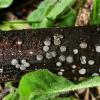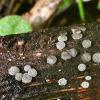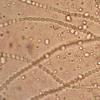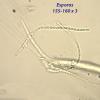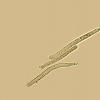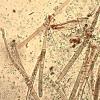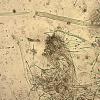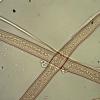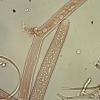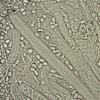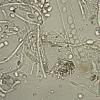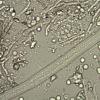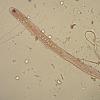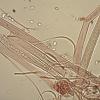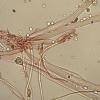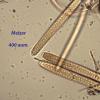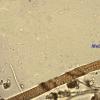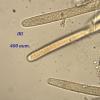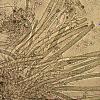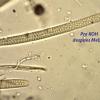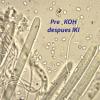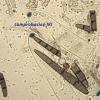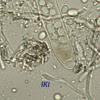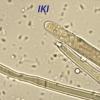
21-12-2025 09:32
Hello.A tiny ascomycete found embedded in wood in

21-12-2025 21:32
Pol DebaenstHello, Garden, Burgweg 19, Veurne, BelgiumOn 10/1

22-12-2025 23:38
Patrice TANCHAUDBonsoir, récolte sur un mur en pierre, apothéci

22-12-2025 00:47
Patrice TANCHAUDBonsoir, récolte à proximité du milieu dunaire

21-12-2025 21:40
Isabelle CharissouBonjour, j'aimerais connaitre les références de

20-12-2025 23:08
Patrice TANCHAUDBonsoir, récolte sur sol sablonneux dans l'arri�
Otro Asco canario
Iglesias Plácido,
16-12-2015 01:53
Ascas: 160-220 x 7-10. IKI negativo.
Parafisos: x 1-3.
En Ferula linkii.
Hans-Otto Baral,
16-12-2015 10:42

Re : Otro Asco canario
Can you show a photo of a mature ascus at higher resolution? To see the ascus apex structure, and also to be sure that these are the ascuspores?
Interesting fungus!
Interesting fungus!
Iglesias Plácido,
16-12-2015 23:38
Re : Otro Asco canario
Hello Zotto, I attach photos to major resolution, it is very difficult to extract them well because they break with many facility, I hope that they you clarify something.
Hola Zotto, adjunto fotos a mayor resolución, es muy dificil sacarlas bien porque se rompen con mucha facilidad, espero que te aclaren algo.
Hola Zotto, adjunto fotos a mayor resolución, es muy dificil sacarlas bien porque se rompen con mucha facilidad, espero que te aclaren algo.
Gernot Friebes,
17-12-2015 08:23
Re : Otro Asco canario
Maybe a Schizoxylon or something similar?
Best wishes,
Gernot
Best wishes,
Gernot
Hans-Otto Baral,
17-12-2015 09:04

Re : Otro Asco canario
Yes, with these images it is a Schizoxylon. the disarticulated part spores are typical. But I cannot imagine a species with inamyloid asci/hymenium. Do you have a photo in which the ascoplasma shows the yellow iodine colour, i.e. the concentration is enough to be sure about an amyloidity? usually Ostropales react hemiamyloid, maybe you overlooked this red reaction.
Iglesias Plácido,
17-12-2015 12:15
Re : Otro Asco canario
En las fotos 3, 4 y 5 se ha utilizado IKI y no se vé una reacción clara. Tomaré más muestras y lo comprobaré.
In the photos 3, 4 and 5, IKI has been in use and not vé a clear reaction. I will take more samples and will verify it.
In the photos 3, 4 and 5, IKI has been in use and not vé a clear reaction. I will take more samples and will verify it.
Hans-Otto Baral,
17-12-2015 12:30

Re : Otro Asco canario
What elements does photo 5 show? On 3 and 4 I do not see the iodine colour, and mainly spores are figured.
Iglesias Plácido,
17-12-2015 12:39
Re : Otro Asco canario
En la 5? asca, parafisis y trozos de esporas, en IKI
Hans-Otto Baral,
17-12-2015 16:34

Re : Otro Asco canario
Are your pics at different scales? I wans't sure that these are asci. And I see nothing of iodine, I suspect your reagent is low-concentrated. You could test mounting directly in your Lugol, without water.
Iglesias Plácido,
17-12-2015 23:08
Re : Otro Asco canario
3, 4 y 5 con 600 aumentos montadas en IKI solo y el resto con 400 aumentos. Prepararé otra muestra con más concentración de Lugol.
3, 4 and 5 with 600 increases mounted in alone IKI and the rest with 400 increases. I will prepare another sample with more Lugol's concentration.
3, 4 and 5 with 600 increases mounted in alone IKI and the rest with 400 increases. I will prepare another sample with more Lugol's concentration.
Iglesias Plácido,
19-12-2015 01:50
Hans-Otto Baral,
19-12-2015 09:43

Re : Otro Asco canario
Yes, thanks! The negative reaction in MLZ would be typical of the hemiamyloid reaction, see my homepage:
http://beta.invivoveritas.de/articles/iodine-reaction-in-ascomycetes-why-is-lugols-solution-superior-to-melzers-reagent/
Your IKI still makes the impression of being only faintly yellow, nevertheless I would expect a reaction there.
To be sure, you could do the following: making a section of a fruitbody (must not be thin), putting on a slide in 2-10% KOH for some seconds, washing the KOH away with water, and then adding MLZ or IKI. If it is then still negative you have won :-)
Zotto
http://beta.invivoveritas.de/articles/iodine-reaction-in-ascomycetes-why-is-lugols-solution-superior-to-melzers-reagent/
Your IKI still makes the impression of being only faintly yellow, nevertheless I would expect a reaction there.
To be sure, you could do the following: making a section of a fruitbody (must not be thin), putting on a slide in 2-10% KOH for some seconds, washing the KOH away with water, and then adding MLZ or IKI. If it is then still negative you have won :-)
Zotto
Iglesias Plácido,
21-12-2015 23:33
Re : Otro Asco canario
Reacción negativa al IKI y al Melzer despues de pretratamiento con KOH. He comprobado el IKI con un Geoglossum y está en buen estado.
Negative reaction to the IKI and to the Melzer after pretratamiento with KOH. I have verified the IKI with a Geoglossum and it is in good condition.
Pensamos que podría ser próximo a Schizoxylon compositum.
Negative reaction to the IKI and to the Melzer after pretratamiento with KOH. I have verified the IKI with a Geoglossum and it is in good condition.
Pensamos que podría ser próximo a Schizoxylon compositum.
Hans-Otto Baral,
21-12-2015 23:44

Re : Otro Asco canario
O.k., this looks convincing though i still wonder why the yellow iodine colour of the plasma is not visible in your preparations. Such colour would make the reaction or its absence trustable.
Iglesias Plácido,
22-12-2015 00:23
Hans-Otto Baral,
22-12-2015 10:46

Re : Otro Asco canario
Yes, now I am happy! Sorry for bothering you so much, but it is really astonishing for me to see an inamyloid Schizoxylon! A problem is that Sherwood in her treatment of the genus doe snoit much care about the iodine reaction.
Did you test Sherwood's key? i see it is necessary to know whether the asci are 4- or 8-spored. Based on your spore length this means whether the spores are 4- or 8-seriate in the ascus.
Did you test Sherwood's key? i see it is necessary to know whether the asci are 4- or 8-spored. Based on your spore length this means whether the spores are 4- or 8-seriate in the ascus.
